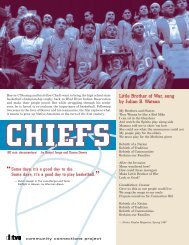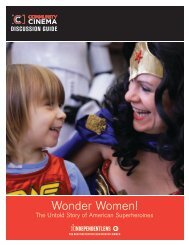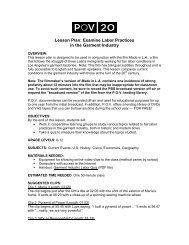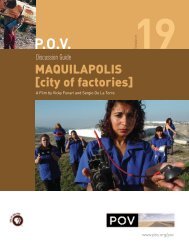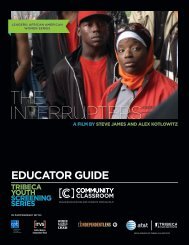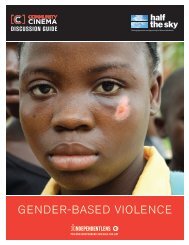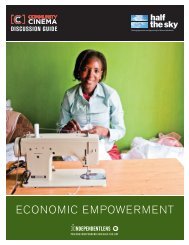LESSON PLANS - ITVS
LESSON PLANS - ITVS
LESSON PLANS - ITVS
- No tags were found...
You also want an ePaper? Increase the reach of your titles
YUMPU automatically turns print PDFs into web optimized ePapers that Google loves.
085HALF THE SKYSex Trafficking and Intergenerational ProstitutionPost-Screening ActivityPart 2: Upstander, Bystander, Perpetrator, Survivor• In this activity, students will consider what it means to be anUpstander, Bystander, Perpetrator, or Survivor and examine theroles that each of the subjects from the film plays in relationship tothe broader crisis of sex trafficking.• Divide the class into small groups of three students and distributeStudent Handout D: Upstander, Bystander, Perpetrator, Survivor.• Ask the groups to review the definitions for each term and rewriteeach in their own words using the handout as a guide. Have eachgroup share its results with another group and refine its owndefinitions and understanding of the terms based on the discussion.• Distribute Student Handout E: Responsibility, Culpability, andUnderstanding and have each group identify a collection of threesubjects from one of the films to focus on for the activity.• Ask each member of the group to select one individual from theircollection of subjects and have each student complete a copy ofStudent Handout E with their character in mind. While completingtheir handouts, the students should consider the complex relationshipthat each subject has to sexual exploitation of women, using thelenses of Upstander, Bystander, Perpetrator, and Survivor, and howtheir interactions with that issue and with each other overlap.• When the students have completed the handout, have each taketurns sharing their subject’s profile with the other members oftheir group. Ask the members of the group to imagine and sharehow their own subjects might respond to the others’ responsesand statements.• Complete the process by instructing each group to discusshow the subjects who were Bystanders or Perpetrators couldmake different choices in order to be Upstanders. Have studentsshare what they think the benefits and consequences of differentchoices might be for him or her and for the other subjects involved.Students can draw on their own experiences and share the toolsthey might use to be an Upstander in this situation.• If time and resources allow, provide a large sheet of kraft paper toeach group and have them create and illustrate speech bubbles fortheir responses to the discussion. Give the class five minutes towalk around the room and review each group’s work.• Review the results of the activity and discuss as a class using thefollowing prompts:--What surprised you most about this activity?--Did any of your subjects play more than one role?--What role do factors such as gender, age, and economic status playin the options each subject had and the choices available to them?--In what ways does understanding the subjects’ relationships toeach other help you better understand the circumstances that ledto the violation of these women’s rights?--How has your understanding of slavery changed since thebeginning of this lesson?--There is a culture of silence surrounding sex trafficking andsexual exploitation of women and children. Survivors oftenexperience social stigma, fear of retribution, and emotionaltrauma and are reluctant to share their stories. What are someof the ways that Somaly Mam’s programs in Cambodia andNew Light in India are breaking those taboos and helpingSurvivors become Upstanders and challenging Bystanders andPerpetrators to reconsider their choices?--What are the consequences of being an Upstander? What aresome of the consequences for survivors who come forward tospeak on their own behalf?--Now that we know about this issue, what responsibility do wehave? How can we be Upstanders for the Survivors of sexualtrafficking?




